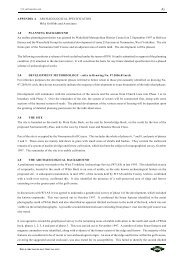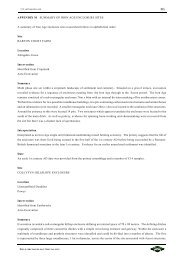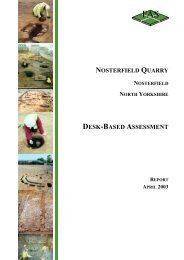ARCHAEOLOGICAL EVALUATION - Mike Griffiths and Associates
ARCHAEOLOGICAL EVALUATION - Mike Griffiths and Associates
ARCHAEOLOGICAL EVALUATION - Mike Griffiths and Associates
Create successful ePaper yourself
Turn your PDF publications into a flip-book with our unique Google optimized e-Paper software.
FAS_lbf01.wpd 23<br />
metres above ordnance datum (AOD).<br />
3.4 FIELDWORK CONSTRAINTS<br />
The site is currently a working farm. In order to limit the destruction of crops <strong>and</strong> disruption to the farming<br />
regime, stages of the evaluation were undertaken during periods when damage <strong>and</strong> disruption could be<br />
minimised. This resulted in stages of the evaluation programme being undertaken at different times in different<br />
zones of the site, <strong>and</strong> in one instance, it was necessary to undertake stages of the investigation out of the logical<br />
sequence.<br />
Certain areas of the site became inaccessible due to the presence of surface water during wet weather (Zones<br />
E <strong>and</strong> F). Investigation of these areas was therefore undertaken after long spells of dry weather.<br />
4.0 FIELDWALKING<br />
The fieldwalking programme was carried out in two phases due to different crop regimes across the site. The<br />
first phase covered an area of approximately 30 hectares (Zones A, B, <strong>and</strong> C) <strong>and</strong> was undertaken in October<br />
2003. Due to the presence of a beet crop in the southeastern part of the site (Zone D), <strong>and</strong> the need to undertake<br />
the evaluation excavation work prior to the ploughing <strong>and</strong> re-sowing of the area, the fieldwalking was<br />
undertaken after the evaluation excavation had been completed. This second phase of fieldwalking covered an<br />
area of approximately 11 hectares <strong>and</strong> was carried out in May 2004.<br />
The ground conditions during the first stage of the fieldwalking resulted in moderate visibility, with a young<br />
relatively dense cereal crop partially obscuring the weathered <strong>and</strong> dry ground surface. Visibility during the<br />
walking of Zone D were considered to be good, with a recently ploughed <strong>and</strong> weathered ground surface.<br />
4.1 FIELDWALKING PROCEDURE<br />
In order to ensure complete fieldwalking coverage of ploughed areas, <strong>and</strong> to avoid any duplication of coverage,<br />
ranging poles were used to divide the site into smaller working areas. These areas were then further sub-divided<br />
into 2.0m traverses which were fieldwalked. All finds were bagged <strong>and</strong> secured to the find-spot using a<br />
surveying flag. Each find was then allocated a unique find number using pre-numbered tags <strong>and</strong> its 3-D position<br />
recorded using a total station theodolite.<br />
All finds were processed <strong>and</strong> catalogued. Information relating to location, material type <strong>and</strong> identity were then<br />
entered into an Access database. XYZ coordinate files were then exported into AutoCAD in order to generate<br />
distribution plots.<br />
4.2 FIELDWALKING RESULTS<br />
A total of 1,460 finds were recovered during the fieldwalking programme. The majority of the finds were<br />
ceramic (625) or ceramic building material (545), with a further 290 finds, of which 201 were lithics, 73 were<br />
FIELD ARCHAEOLOGY SPECIALISTS







